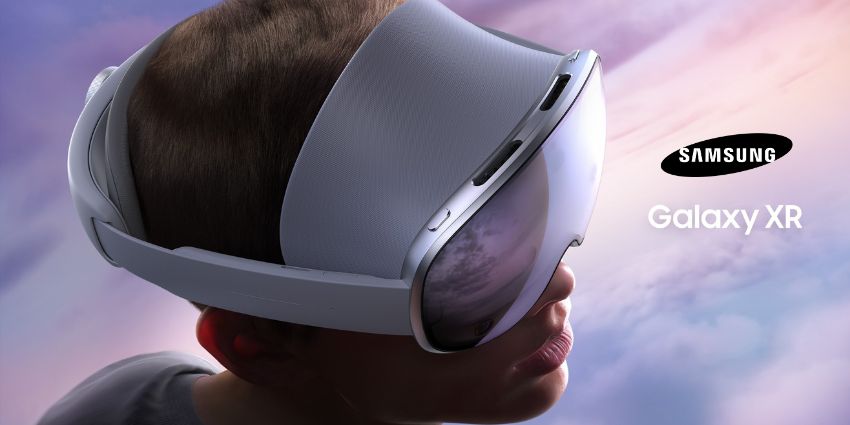An engineer in Manchester leans over a whining turbine. A remote specialist in Singapore sees the scene through augmented reality glasses, drops a quick sketch into the worker’s view, and the fix works on the first try. No guessing or juggling phones. Just hands-free, heads-up guidance that feels like a natural extension of your unified communications stack.
That’s where we are with augmented reality devices today. Over the last few years, this conversation jumped from “what is AR?” to “how do we make an augmented reality device part of daily workflows for field teams, training, and hybrid meetings?”
Market signals back it up: global smart-glasses shipments surged about 110 percent in the first half of 2025, and it suddenly seems like every vendor wants a piece of the action: Meta, Samsung, even Apple. The biggest job for business leaders right now? Deciding where to dive in.
What Are Augmented Reality Devices?
We’re all pretty familiar with augmented reality (AR) at this point. We’ve got it in our phone apps, on websites, and even popping up in certain retail stores. AR is just technology that blends information and images with the real world. Augmented reality devices are what let us interact with that content.
Every augmented reality device runs on the same simple loop:
- It sees through cameras and depth sensors that scan what’s around you, from machinery to human gestures.
- It understands using onboard AI chips that analyse those visuals, detect patterns, and decide what matters.
- It shows projecting data, instructions, or digital models back into your actual field of view through micro-displays and spatial sound.
The loop has never been this refined. The newest augmented reality glasses, running on Qualcomm’s Snapdragon XR2+ Gen 2 and powered by Android XR or Apple’s VisionOS 2, stay cool, respond instantly, and connect straight into the platforms people already use: Teams, Zoom, and Webex.
The intelligence built inside these wearables has matured too. They can translate speech on the fly, display live captions, or pull maintenance data the instant you glance at a piece of equipment. A few years ago, that required a full headset and a power pack. Now it fits into lightweight frames you can wear all day.
In practice, these augmented reality devices have become portable control centers. They give frontline workers, designers, and managers an information layer that moves with them, not another screen to check, but another sense to use.
The Types of Augmented Reality Devices for Businesses
There’s no one-size-fits-all augmented reality device anymore. The market has diversified fast, offering everything from phone-based AR experiences to professional-grade glasses that run entire collaboration suites. For business leaders, understanding that spectrum helps you choose hardware that drives real operational value instead of gathering dust in a drawer.
Smartphone or Tablet Augmented Reality Devices
For many teams, the first taste of augmented reality isn’t through headsets or smart glasses. It begins with something far more ordinary: a phone. ARKit and ARCore have quietly turned smartphones into tools for spatial work, letting users drop 3D visuals into their surroundings with a quick tap. You can overlay a floor plan on an empty office or preview a product in full scale before ordering it.
Nearly every smartphone sold today can already handle this. The technology isn’t waiting on the future; it’s been sitting in your pocket all along.
Construction firms use mobile AR to preview new infrastructure before a single beam goes up. Sales teams pull up 3D product models during client meetings to shorten buying cycles. Retailers like IKEA and Sephora let customers “try before they buy” in their own space.
The result? A simple, low-risk way to prove the business case for AR. No headsets. No training curve. Just the first step toward more immersive, hands-free experiences later on.
The trouble is, it’s not an entirely “immersive” experience. You need to hold your smartphone up in front of you, and the experience you get will be limited based on the size of your screen, the app, and the computing power used.
Kiosk Systems, Large Displays, and AR Projectors
Kiosk systems and larger displays (like AR mirrors), are basically the expanded version of a tablet or smartphone AR experience. They’ve become a lot more common in recent years, ever since Uniqlo joined forces with Holition in 2012 to create the very first virtual fitting room.
These augmented reality devices aren’t just for retail, though. In offices, some AV vendors have been experimenting with augmented reality meeting and workflow experiences. You might have a projector system that displays interactive content over a table, or shows you the parts of a machine superimposed onto the device itself.
Already in healthcare, AR projectors are helping professionals with surgeries, showing them how veins and organs are mapped out as they work. These devices are large in scale, so there’s nothing for a user to wear or carry around, but they can be expensive and complicated.
WebAR: Collaboration That Starts With a Link
If mobile AR is the doorway, WebAR is the open hallway beyond it. There’s no app to download or update. It runs inside a browser, quick and light. For large organizations with teams spread across countries, that simplicity matters. It’s an easy way to deliver interactive training or marketing experiences without the technical friction.
Imagine a European telecom used browser-based AR to onboard hundreds of field engineers. That way, new hires could access 3D guides of equipment layouts by scanning a QR code, cutting training time massively. Marketing teams are using it too; clients can place a life-size product demo on their desks within seconds.
For most companies, WebAR is a simple way to get employees and customers comfortable with AR before introducing dedicated augmented reality devices.
Again, though, you’re going to be limited if you’re looking for true full-scale immersion. That takes us to the next category, arguably the one grabbing the most attention right now.
Smart Glasses: Hands-Free and Business-Ready
This is where the technology starts to feel alive. Smart glasses are light, wearable augmented reality devices that layer information into a worker’s view: instructions, data, or translations, all without stopping the task. In 2025, several strong contenders arrived, showing just how far this category has come.
- Meta Ray-Ban Display Glasses use micro-LED displays and an onboard AI assistant for captions, messages, and quick documentation.
- Samsung AR Glasses, built on Android XR, handle real-time translation and document scanning, ideal for international service teams.
- XREAL One Pro and Beam Pro deliver bright, high-resolution overlays for design and collaboration at a fraction of headset cost.
The results from these tools are measurable. DHL’s vision-picking program improved warehouse efficiency by roughly 25%. Manufacturers using augmented reality glasses for remote guidance saw repair times drop by as much as 40%, while travel costs plummeted. PwC found that immersive training with AR cuts learning time by 60% and reduces human error by 70%.
With several enterprise-ready models now priced under $1,000, smart glasses are a realistic addition to 2026’s IT budgets. The tricky part is choosing the ones that work best.
Emerging AR Devices for the Enterprise
At the high-performance end of the market, MR and AR headsets bring depth, context, and spatial computing together for design, engineering, and hybrid collaboration.
The Samsung Galaxy XR, powered by the Snapdragon XR2+ Gen 2 chip and Gemini AI, supports Android XR’s entire ecosystem. It’s already being used for factory data visualisation and real-time collaboration in logistics. Apple’s Vision Pro and the upcoming Vision Air use VisionOS 2 to create multi-window “workrooms” where teams can brainstorm inside 3D models.
Outside of headsets, a few more “niche” ideas have been earning attention too. AR Laptops could one day become a real thing, even though companies like Sightful decided to ditch theirs in the last couple of years. AR contact lenses have potential too.
We still don’t have any consumer-ready prototypes to explore, although various vendors have introduced concepts at world-leading events. For instance, in MWC 2024, the XPANCEO team generated hype with a selection of smart contact lenses, some of which had unique extended reality capabilities.
Why Businesses Are Investing in Augmented Reality Devices Now
It’s taken a long time for augmented reality devices to feel natural at work. After years of tests and false starts, they finally fit. A technician can now stream their view over Teams or Zoom without juggling extra steps. IT staff can secure and update devices through familiar tools like Intune or Knox, the same way they handle phones and laptops.
The biggest shift isn’t in performance, it’s in perception. People have stopped thinking of AR as a gimmick. It’s become another way to talk, teach, and solve problems together. At Siemens, BMW, and Clorox, teams use AR to train staff and troubleshoot from afar. Downtime drops. Mistakes shrink. And distance matters a little less.
How to Choose the Right AR Devices for Your Business
Choosing augmented reality devices for your business isn’t about chasing flashy specifications. It’s about finding tools that fit your people and making sure those tools support daily work rather than interrupting it.
Start with the basics: integration. A good, augmented reality device should play nicely with your existing systems. If your teams already live in Teams, Zoom, or Webex, look for models that connect without awkward workarounds. The less friction, the faster adoption spreads.
Next comes management and trust. IT departments have little patience for one-off gadgets, so pick devices that can be monitored and updated through familiar platforms like Meta for Business, Intune, or Samsung Knox. When security fits into existing frameworks, rollout becomes less of a battle.
Then think about context.
- Field engineers need smart glasses that let them share what they see while keeping their hands free.
- Designers or architects might get more out of a spatial headset with 3D environments.
- Trainers and sales teams can start small with browser-based AR before scaling to wearables.
Comfort is still the deal breaker. If a pair of augmented reality glasses feels heavy, overheats, or dies halfway through a shift, it won’t make it past the first week. The smarter approach is to start small. Test it in one department, listen to the people using it, and expand once the results show up in the numbers.
The Future of Augmented Reality Devices in the Workplace
Augmented reality devices are finally going mainstream because the hardware and software are catching up with the imagination of the people using them.
Companies that once experimented in labs are now scaling production pilots and onboarding programs built entirely around augmented reality glasses or headsets.
The biggest breakthroughs are coming from design, comfort, and intelligence. Micro-LED optics and lighter materials are shrinking the form factor, while waveguide lenses make digital overlays look as crisp as reality. AI is also starting to act as the “co-pilot” inside every augmented reality device, translating speech, summarizing conversations, and offering contextual prompts before you even ask.
But perhaps the most important trend is cultural. The more these devices disappear into the background, the more natural work becomes again. No screens to divide, no cameras to pose for, just people, data, and context sharing the same space.







